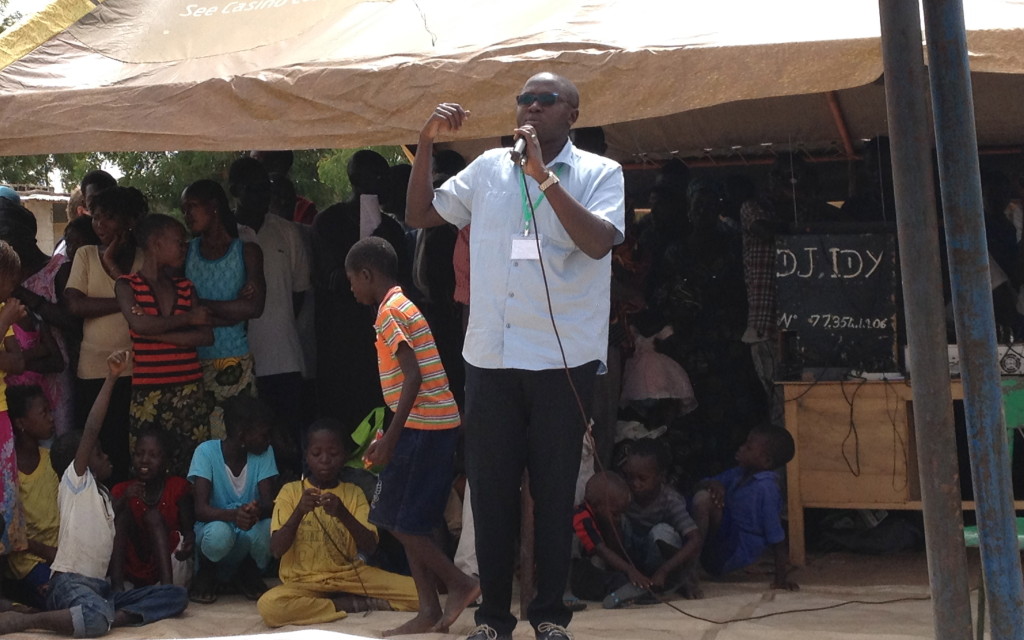Senegal SUN Movement Learning Route: Scaling Up Nutrition – a community-based perspective
After a short courtesy visit to the governor of the Kaolack region on Tuesday morning, the expedition headed towards the rural community of Patar Lia. As they stepped off the bus, participants discovered the colorful welcome prepared by the community. In front of a welcome banner positioned at the entrance to the main square and tents to protect all of the ceremonies participants from the late morning sun, rural councilors, women and children of the rural community lined up to receive the delegation.

Photo: SUN/Maria Pizzini
Not even a four hour bus drive, the aches and pains of fatigue, a blazing sun rising over Kaolack or a temperature of 40 degrees (in the shade) dampened the curiosity and enthusiasm of the participants in their visit outside of the Senegalese Capital of Dakar.
After a short courtesy visit to the governor of the Kaolack region on Tuesday morning, the expedition headed towards the rural community of Patar Lia. As they stepped off the bus, participants discovered the colorful welcome prepared by the community. In front of a welcome banner positioned at the entrance to the main square and tents to protect all of the ceremonies participants from the late morning sun, rural councilors, women and children of the rural community lined up to receive the delegation.
The feverish sounds of drums, chants and applause completed the atmosphere. The Learning Route participants then joined representatives from the Rural Council for an in-depth discussion regarding the involvement of the Local Community in the implementation of nutrition activities. The President of the Rural Council proudly explained the activities carried by the Community Implementing Agencies under his direction.
After two hours of questions and answers, the delegation headed towards Gossas village to learn more about their community nutrition activities. With a tent pitched, chairs and mats spread across the ground and flipchart paper secured to the walls – the heart of the village was transformed into an outdoor classroom for scaling up nutrition.
Women and children from the community gathered on the chairs and mats, enriching the afternoon’s lesson. For the next few hours the participants had the opportunity to discover all the nutrition services delivered by community volunteers with support from the local steering committee and under the supervision of the community worker.
The group discussed growth monitoring and promotion, communication for behavior change as well as surveillance and management of malnutrition. To conclude the visit, the village invited the Learning Route participants to join them for a family-style meal of chicken and rice.
The second day of field visit started with an early journey through the streets of Kaolack towards Palado. This village, populated mainly by ethnic Serer inhabitants, has one of the region’s largest salt production sites. Through a dynamic Economic Interest Group (GIE), and with the help of Universal Salt iodization Project, the village has been able to build a thriving economic sector from salt mining for the benefit of the community.
For example, thanks to profits from the sale of salt, the village has been able to build a new classroom at the local school, buy supplies and provide health care for some community members. The Universal Salt Iodization Project involves partners and key stakeholders such as the Ministry of Commerce and the Chamber of Artisanal Crafts (whose role is to supervise small producers and support marketing).
Participants in the learning route were able to exchange with representatives from these groups to better understand the implementation of the project. At their last stop, the learning route participants were welcomed to the tune of Senegal’s national anthem brilliantly sung by the children of the Touba Ndonrong early childhood center.
For the next half an hour, the children entertained the group with their songs, dances and a skit on the importance of a diversified diet. Early childhood centers like these are an essential component of nutrition support in Senegal. These institutions focus their support on both women and their children presenting a great opportunity for the efficient delivery of a package of health and nutrition services.
Tested by the heat and fatigue but inspired by the implementation of nutrition activities, participants boarded the bus with smiles and satisfaction. After a short break at the hotel, the Learning Route participants headed back Dakar to continue to reflect on what they learned and discuss how they will apply these lessons upon return to their countries.